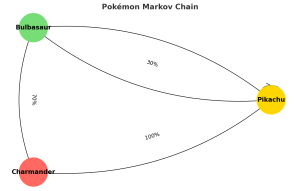(con’t from here) Instead of choosing which Pokémon shows up, the grass has its own secret rules:
•If you just saw a Pikachu, the grass says: “Next time, there is a 50% chance you will see another Pikachu, and a 50% chance you will see a Bulbasaur.”
•If you just saw a Bulbasaur, the grass says: “Next time, there is a 70% chance you will see Charmander, and a 30% chance you will see Pikachu.”
•If you just saw a Charmander, the grass says: “Next time, you will always see Pikachu.”
Now the adventure begins. You meet a Pokémon, and that decides the chances of who comes next.
Here is the cool part:
•The grass does not care what happened ten steps ago.
•It only cares about the Pokémon you just met.
•That is the whole “Markov chain” idea — the next step depends only on now.
So when you are wandering, it feels like a story: Pikachu → Bulbasaur → Charmander → Pikachu → Pikachu… and so on. It is a bit like the world is rolling dice behind your back, using rules that depend on the Pokémon in front of you.
•Pikachu has a 50/50 chance to stay Pikachu or switch to Bulbasaur.
•Bulbasaur is most likely to lead to Charmander (70%), but sometimes goes back to Pikachu (30%).
•Charmander always jumps straight to Pikachu.

So the arrows are the “secret rules” of the tall grass!

